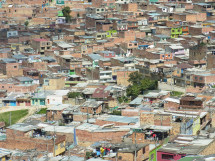Ideas into movement
Boost TNI's work
50 years. Hundreds of social struggles. Countless ideas turned into movement.
Support us as we celebrate our 50th anniversary in 2024.

The opening in September 2012 of the first centre for drug addicts in Bogota is a welcome first step towards more humane and effective drug policies in Colombia’s capital city, but to be effective needs to be integrated into proper overall drugs strategy.

In September 2012, the mayor of Bogotá, Gustavo Petro, launched the first centre for drug addicts in the Bronx, a marginalised city-centre neighbourhood. Called the Medical Care Centre for Dependent Drug Users (Centro de Atención Médica a Drogodependientes - CAMAD), it is staffed by psychiatrists, psychologists, doctors and nurses. The people given care in these centres are in an at-risk situation and socially excluded due to their high levels of drug dependency. They are people linked to criminal activities associated with the use and sale of drugs, and they often suffer from mental illness associated with drug use and diseases resulting from problem drug use.
Petro revealed that the national government “authorised” his proposal to supply controlled drugs to dependents only under a strict medical prescription. The initiative seems to fit within a broader new appraisal of drug control policies in Colombia. On several occasions in the last few months, President Juan Manuel Santos has announced that it is necessary to take forward an analysis and debate about the results, effectiveness and future prospects of the socalled “war on drugs,” and the possible alternatives to it.
The initiative represents a first step in an attempt to design more humane and effective drug policies in the country’s capital city, and reflects a shift away from the approach characterised by police crackdowns. As such, it should be positively welcomed.
Nevertheless, the introduction of the CAMAD provoked a fierce debate in the press, the Attorney General’s office and the political community, due to the lack of clarity about the scope of the initiative in the absence of a strategy to deal with the complex issues involved in problem drug use, poverty and exclusion in run-down areas of Bogotá.
As drug expert Ricardo Vargas pointed out, one of the shortcomings that emerged when the CAMAD were announced was the absence of a drug policy strategy within which the initiative ought to be carried out. “The very announcement of the CAMAD is in itself something which should be subordinate to a strategy that hasn’t yet been presented,” Vargas argued. “In other words, the instrumental, secondary aspect has come to be seen as the key component of the strategy, and this distorts the complexity of the problem and the policies that ought to be drawn up.”
For good or bad, the nature of the measure has hit the front pages in the media but, as Vargas says, “… very few people have been asking the more important questions: What is the strategy that the CAMAD initiative forms part of? Does the city have a drugs strategy that is the result of a serious and coherent process of research and reflection? Why did the mayor present the CAMAD to the public before his drugs strategy?”
This report presents a brief account of the history of the relationship between the state and drug trafficking, and the open war declared by the traffickers at the end of the 1980s. It then goes on to describe the different stages in the way the drugs issue has been addressed, both in terms of legislation and in policies on health in the country. Against this background, the technical and legal assumptions behind proposals such as the CAMAD in the city of Bogotá are set out. The report concludes by offering a list of recommendations to continue making progress in the reform of drug policies.
Recommendations for the government and civil society
photo by Sterneck
Pages: 12